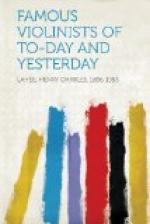In 1798, when Kreutzer was at Vienna in the service of the French ambassador, Bernadotte, he made the acquaintance of Beethoven, and was afterwards honoured by that great composer with the dedication to him of the famous Sonata, Op. 47, which was first played by Beethoven and the violinist Bridgetower, at the Augarten, in May, 1803, either the 17th or the 24th. This is the sonata the name of which Count Leo Tolstoi took for his famous book, though to the vast majority of hearers it will always remain a mystery how the classical harmonies of the sonata could have aroused the passions which form the raison d’etre of the book.
Kreutzer was noted for his style of bowing, his splendid tone, and the clearness of his execution.
With three such masters as Baillot, Rode, and Kreutzer, besides Viotti, who was frequently in Paris, the French school of violin playing had now superseded the Italian.
Pierre Marie Francois de Sales Baillot, who was associated with Rode and Kreutzer in the compilation of the celebrated “Methode du Violon,” was born at Passy, near Paris, in 1771, and became one of the most excellent violinists that France ever produced. His eminence in his profession was not obtained without a long struggle against great difficulties, for at the age of twelve he lost his father, who had kept a school, and became dependent upon friends for his education. His musical talent was remarkable at an early age, and he received his first instruction from an Italian named Polidori. At the age of nine he was placed under a French teacher named Sainte-Marie, whose training gave him the severe state and methodical qualities by which his playing was always distinguished.
His love for his instrument was greatly augmented when, at the age of ten, he heard Viotti play one of his concertos, and from that day the great violinist became his model.
When his father died a year or two later, a government official, M. de Boucheporn, sent him, with his own children, to Rome, where he was placed with Pollani, a pupil of Nardini, under whom he made rapid progress, and soon began to play in public. He was, however, unable to follow directly in the path of his profession, and for five years he travelled with his benefactor, acting as private secretary, and securing but little time for his violin playing.
In 1791 he returned to Paris, and Viotti secured a place for him in the opera orchestra, but on being offered a position in the Ministere des Finances, he gave up his operatic work, and for some years devoted only his leisure to the study of the violin. He now had to serve with the army for twenty months, at the end of which time he once more determined to take up music as a profession, and soon appeared in public with a concerto of Viotti. This performance established his reputation, and he was offered a professorship of violin playing at the Conservatoire, then recently opened.




